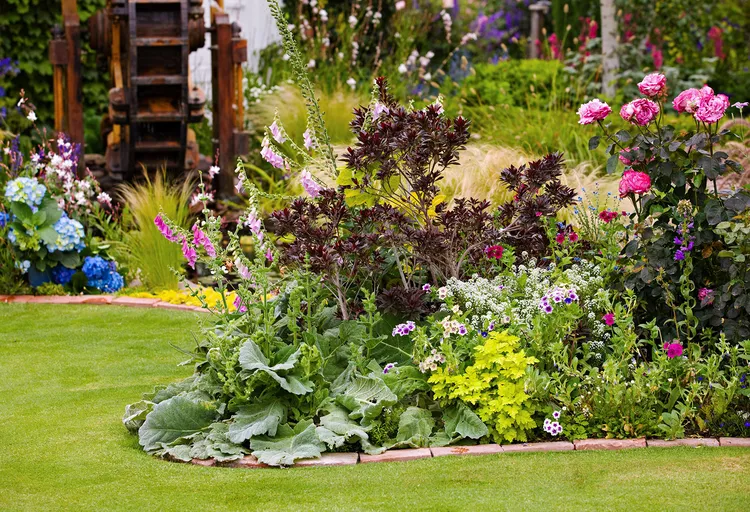Most well-designed landscapes have various areas that serve different purposes, such as a vine-covered sitting area, a vegetable garden, or a flower border. Landscape edging helps accentuate each of these separate spaces while lending a unifying element to your garden's design.
Edging can also be functional, such as holding mulch in place and preventing mowers from damaging your prized plants. Depending on your aesthetic and purposes for edging, options range from a simple trench to high-end paving stones and everything in between. We'll help you sort through all the considerations to decide which landscape edging will work best in your garden.
Landscape Edging Uses
Edging creates clean, crisp lines between beds and other areas. It's most visible between a lawn and an adjoining garden, but landscape edging can define a border, a shrub bed, a single tree, or the transition from a patio to the surrounding landscaping. It emphasizes the lines and edges and leads the eye to the next garden focal point.
From a practical standpoint, landscape edging helps to keep turfgrass from creeping into surrounding garden areas. At the same time, it prevents soil or mulch in garden beds from spilling onto the lawn whenever you water, or it rains. Landscape edging also corrals pathways made of loose material, such as gravel or mulch; it maintains clearly defined walkways while keeping the path materials in place.
Taller landscape edging options, such as short hedges or low fencing, can help keep people on defined paths. Landscape edging also keeps visitors out of areas you don't want them to go, such as planting beds.
If landscape edging is flat and wide enough, it can handle the wheels of a lawn mower. A practical mowing strip created by landscape edging eliminates the need for manicuring the edges with a string trimmer, and it prevents you from mowing over tender plants in beds at the edge of a lawn.
Edging should be set firmly in place. Otherwise, mowers, garden carts, children, or your feet can unsettle it, and you'll repeatedly reset materials.
Landscape Edging Types
A wide range of materials can work as landscape edging, so there's something to suit the function, style, and cost you have in mind.
Lawn & Garden Divider: As a divider between the lawn and garden beds, edging can be as simple as a trenched edge or a shallow, V-shaped ditch.
Mowing Strip: Use a flat, wide material, such as brick or flagstones, to create a firm base suitable for the wheels of a lawn mower.
Mulch Capture: To keep a heavily mulched bed in place, use a material that extends at least 2 inches above the ground (and 4 inches below).
Beauty Edging: If the edging is purely aesthetic, options are virtually limitless!
Landscape Edging Styles
Consider the other hardscaping materials when selecting an edging style for your garden. Edging can be a unifying factor, but if it introduces a new material to the garden scheme, it could be a distraction.
Brick, stone, or pavers can unify the edging with a patio or path. Fencing can help connect to a pergola or trellis. Low shrubs can blend into the planting beds for a defined but natural look. Unexpected materials, such as tile, glass, or metal landscape edging, can be used with standard edging materials to match accents from other garden areas.
Landscape Edging Costs
Costs depend on the material type and quantity. For example, repurposed stones may be free; tiles or brick may be costly.
If an expensive edging material is your dream, consider using it sparingly, like in areas that will be seen up close and often, such as the front yard. Or use it as an accent near garden focal points. More affordable materials can be both pretty and practical elsewhere in the garden.
In addition, include the cost of installation in your landscape edging plans. Different materials' installation costs vary, as does the ease of building it yourself. Some materials require professional installation or special tools to get the desired look. Others lend themselves to an easy DIY project.
Landscape Edging Colors
The color of the edging has a big impact on your garden. Use landscape edging in a color that either complements or clearly contrasts with the surrounding foliage and flowers. In casual settings, link the edging to the garden bed by using plants of a similar color or tone. For more formal beds and edging, use uniform materials, such as steel, wood, brick, or prefabricated masonry.
Landscape Edging Materials
Visit your local home improvement store, and you'll find landscape edging made out of plastic or even metal. You can also make edging out of materials such as brick, wood, or stone. But don't feel limited by what you can buy. You can also get creative and make your edging out of everyday items like fallen twigs, branches, or even upended wine bottles. Each material has its advantages.
- Brick: Elegant and long-lasting, brick comes in a multitude of styles and is a good idea for a uniform look.
- Plastic: Affordable and easy to install due to its flexibility, plastic edging comes in many grades. The least expensive look it, so invest in the best you can afford.
- Concrete: You can purchase preformed sections of concrete landscape edging that are ready to be set in place, or you can make a simple form and create a custom edge.
- Wood: Affordable and easy to work within straight lines, wood adds an informal, organic look. Count on wood edging to last about ten years.
- Stone: One of the more versatile materials, landscape edging stone can be carefully set in mortar for a refined look or placed more casually for a relaxed appearance.
- Wattle: This edging uses a technique that involves weaving saplings of pliable wood, such as willow or dogwood, into a low fence. Wattle works well for holding back mulch.




















